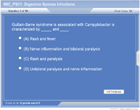| How to Learn in 24 Hours? |
|
| Need Help? |
M-F: 9am-5pm(PST):
Toll-Free: (877) RAPID-10
or 1-877-727-4310
24/7 Online Technical Support:
The Rapid Support Center
vip@rapidlearningcenter.com
Secure Online Order:

|
| Tell-A-Friend: |
Have friends taking science and math courses too? Tell them about our rapid learning system.
|
|
Digestive System Infections
| Topic Review on "Title": |
- The digestive system is often divided into two sections: gastrointestinal (GI) system is the tubular path from the mouth to the anus.
- The second section is referred to as the accessory digestive organs. The accessory digestive organs are responsible for either grinding the food (teeth) or injecting digestive secretions (pancreas).
- The internal surface of the small intestine has millions of hair like projections called villi.
- Intestinal peristalsis moves undigested and unabsorbed food from the small intestine into the large intestine and colon.
- The colon finishes the absorption of nutrients and water.
- Feces is the remaining undigested material which is eliminated via the anus. As much as 40% of the fecal volume is bacteria.
- Antigenic drift and antigenic shift primary mechanism for production of new strains of flu.
- The membrane covering most of the GI tract and protects it is called the peritoneum.
- Accessory digestive organs include tongue, teeth, liver, gallbladder and pancreas.
- The esophagus, stomach and small intestine (duodenum) are almost free of microbes.
- Gastroenteritis is an inflammation or irritation of the lining in the: stomach or intestines.
- Bacteria growing on the tooth’s surface make acid which then destroys the enamel.
- Gingivitis is an inflammation of the gums surrounding the teeth.
- Bacterial gastroenteritis is an inflammation of the stomach and intestines caused by bacteria or bacterial toxins.
- Bacterial pathogens of the gastrointestinal tract, attach and bind to the surface, proliferate and transmit disease. These microbes develop mechanisms that optimize these characteristics while minimizing the host’s ability to destroy them.
- Viral gastroenteritis is an intestinal infection caused by several different viruses.
- Hand washing is the single most important way to avoid infection of the digestive system
- Fecal Oral route is a major cause of digestive diseases due to infection.
- The human heart is a muscle with four chambers.
|
| Rapid Study Kit for "Title": |
| Flash Movie |
Flash Game |
Flash Card |
| Core Concept Tutorial |
Problem Solving Drill |
Review Cheat Sheet |
 |
 |
 |
|
| "Title" Tutorial Summary : |
The digestive system is made up of a series of hollow organs that are joined together by a flexible tube that extends from the mouth to the anus. The tube has a lining called the mucosa. In the mouth, stomach, and small intestine, the mucosa has small glands that make digestive juices used to break down foodstuffs. The mucosa is a target of many infectious agents. It is the site that bacteria, viruses, protozoa and worms attach to in order to replicate and invade the rest of the body.
The liver and the pancreas also contribute digestive juices that are secreted to the intestine.
The digestive system will be presented in order to better understand how infections occur within it and how symptoms arise from specific diseases. Bacteria and virus are prokaryote organisms that can infect the digestive system and a select few will be presented that represent a significant impact on human health. Heminthic (worms) and protozoan infections will be presented that represent eukaryote infectious agents of the digestive system.
|
| Tutorial Features: |
Specific Tutorial Features:
- The structure of the digestive system is schematically outlined.
- Pathogenic bacteria, viruses, protozoa, helminthics and toxins in the digestive system.
- Animations of pathogen Life Cycles
Series Features:
- Concept map showing inter-connections of new concepts in this tutorial and those previously introduced.
- Definition slides introduce terms as they are needed.
- Visual representation of concepts
- Animated examples—of concepts are used to step wise breakdown a concepts.
- A concise summary is given at the conclusion of the tutorial.
|
| "Title" Topic List: |
Structure and function of the gastrointestinal tract.
Structure and function of the accessory Digestive Organs.
Bacterial, viral and protozoan diseases of the digestive system.
Helminthic infestations of the intestinal tract.
The microbiota of the digestive system is not spread evenly throughout.
|
See all 24 lessons in Anatomy and Physiology, including concept tutorials, problem drills and cheat sheets:
Teach Yourself Microbiology Visually in 24 Hours
|



